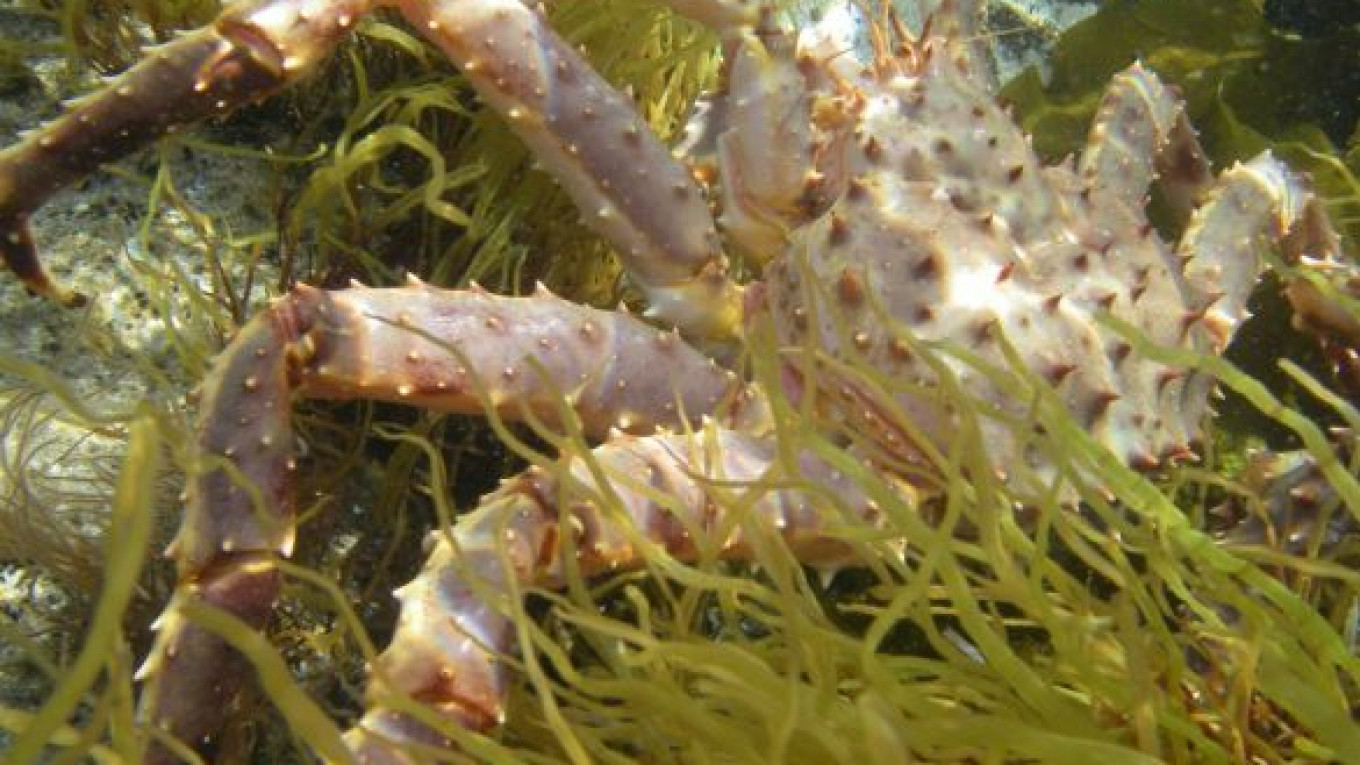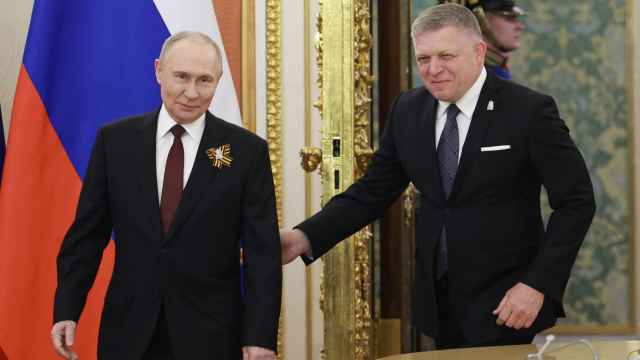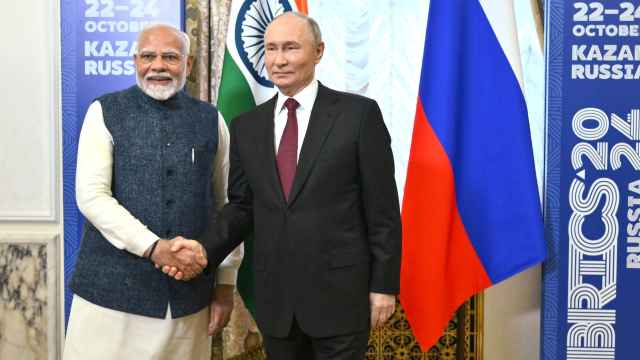Soviet botanist Ivan Machurin’s immortal phrase “We cannot wait for favors from nature. To take them from it — that is our task” could be the all-encompassing slogan by which Russia’s resource-driven economy now lives.
Even though the early 20th-century scientist was primarily referring to creating plant hybrids, his philosophy underpinned many of the Soviet Union’s ambitious experiments with nature — from reversing river flows to the Kamchatka crabs that were transplanted to the Barents Sea in the 1960s in an effort to increase the productivity of the northern sea.
Half a century later, the spiny giants are the region’s most lucrative catch — but this experiment with biodiversity has had a string of economic, environmental and social effects on the fishing communities of the Barents Sea.
No Accidental Tourist
With a life span of up to 30 years and growing up to 2 meters across, the Kamchatka crab — also called the red king crab — is a hardy native of the North Pacific, taking its name from the peninsula where Russians first encountered it.
Between 1961 and 1969, scientists seeking to boost the commercial productivity of Russia’s Arctic Sea released 13,000 of the creatures and 1.6 million larvae into Kolafjord in the east Barents Sea — thousands of miles from their Pacific home.
The results of the experiment were at first disappointing. Although Norwegian fishermen soon began to find Kamchatka crabs in their nets with increasing regularity — the crabs appear to have marched toward Norway against the warm Gulf Stream current soon after being introduced — at first their presence in Soviet waters was negligible.
But the crustaceans were only biding their time. Many introduced species multiply only very slowly until reaching a “critical mass” when the population explodes. The Kamchatka crabs in the Barents were no exception.
The red king crab is now found across about 100,000 square kilometers of the Russian part of the Barents Sea, and the total population is estimated at about 9.25 million individuals, of which 1.48 million are thought to be of commercial value.
Red Gold
Commercial fishing of the Barents crabs began in Russia at the end of 2004, and by 2008 it had become the most economically significant species in the region, with 1 kilogram of crab meat retailing for about $100 — almost double the price of red caviar, yielding almost 5 billion rubles ($161 million) of annual turnover to local fishing companies.
Anecdotal evidence says most of the catch is exported, although the Federal Fisheries Agency was unable to confirm the numbers.
Fishing of the crab in Russia is controlled by government quotas that vary from year to year, based on population surveys by the Murmansk-based Knipovich Polar Research Institute of Marine Fisheries and Oceanography, or PNIRO — created specifically for research of Barents Sea fish life — and the Federal Institute of Fisheries and Oceanography, or VNIRO. Currently quotas vary from 5,500 to 6,000 tons per year.
But as with any lucrative commodity, deciding who gets to harvest these quotas is fraught with controversy.
When commercial fishing began, rights to harvest the crab were auctioned to fishing companies in the area.
Licenses came in two main categories: inshore harvesting within 12 nautical miles (about 22 kilometers) of the coast, which were mainly granted to small, local companies; and rights to harvest the crabs further from shore, which were sold to major corporations, such as The North West Fishing Consortium, which has four companies crab fishing in the Barents.
But in 2011 the federal government introduced a ban on harvesting the crab within 12 nautical miles of the shore — effectively rescinding the rights bought by smaller fishermen in 2005.
The official reason for the ban is conservation to protect breeding populations, based on research by PNIRO that found most of the crabs in the inshore zone are reproducing females and youngsters.
But some suspect ulterior motives.
“There are several reasons why this ban may exist: development of red king crab fishing in territorial waters is not in the interest of holders of main quotas, and once again, where there is poaching there is corruption,” said Vassily Spiridonov, senior researcher at the Laboratory of Coastal Ecosystems of the P. P. Shirshov Institute of Oceanology of Russian Academy of Sciences.
Some researchers have questioned PNIRO’s findings, arguing that many male crabs are also found close to the shoreline and that young crabs are also found beyond the exclusion zone.
They also argue that fishermen can easily avoid catching females and youngsters by changing the design of the cages to allow them to escape.
“[The locals don’t] understand the reasoning behind the ban on harvesting females and [their eggs],” said Mikhail Pereladov, head of coastal research at the VNIRO institute. “The caviar is delicious; there are plenty of female and young crabs. Norway allows them to be caught, and here we can’t even raise the issue,” he said.
“Our people are suffering,” said Anatoly Yevenko, general director of the Association of Coastal Fishing Industrialists and Farms of Murman, a trade association the fishermen have formed to defend their interests.
“This legal chaos is crushing them. The good intentions of our government are paving these companies’ path to hell,” he said. Yevenko, whose association represents 32 companies operating in the region, said that many of the businesses that won tenders for inshore quotas but are now prohibited from fishing are facing bankruptcy.
“These licenses were bought by companies that spent a lot of money on them. Now it turns out they cannot harvest Kamchatka crabs close to the shore,” Yevenko said.
He added that the ban was briefly lifted last year after fishermen protested the issue, but that it was soon reinstated
This year “the crab-harvesting companies approached me, and I wrote a letter [in March] to [then] President Dmitry Medvedev requesting that this issue be resolved,” Yevenko said. He received a reply in late April that was essentially negative, reiterating the scientific case for banning inshore fishing and that legislation forbids companies with near-shore permits from fulfilling their quotas beyond the 12 nautical mile limit.
Yevenko said the fishermen he represents are unsure of what their next move should be.
A spokeswoman for The North West Fishing Consortium denied the ban is in the consortium’s financial interest because its companies hold about 70 percent of all inshore quotas, but said that they accept the research which states that the ban is necessary for the protection of the crab population.
She declined to say what proportion of the consortium’s crab business is made up of inshore quotas versus quotas beyond the 12 mile exclusion zone.
Poaching
Meanwhile, illicit crab fishing is booming.
Nobody knows the true scale of illegal poaching in the area, said Pereladov, of the VNIRO institute.
“But there are rumors that in the Motovsky Gulf alone, more than 100 light-tonnage ships are harvesting crabs,” Pereladov said, adding that much of the Barents Sea is officially off limits to any sea traffic because it is a border area.
“In our country it seems that everybody is OK with [illegal harvesting], as long as the poachers are paying off the appropriate agencies,” Spiridonov of the Shirshov Institute said.
Pereladov estimates that crab obtained illegally is sold on the Russian market at half or even a third of its official price.
Although inexpensive, poached crab is an incredibly destructive commodity.
“Local people want to be able to harvest crabs, openly. To have enough time to choose crabs of the highest quality, and to use all of the crab,” Pereladov said.
“But when a poacher is at sea every minute counts. After a crab is on deck they break off its primary leg (which is the most expensive part) and the rest is thrown overboard — up to 80 percent of the meat is wasted,” he added.
The result is ironic. Russian legislation, which protects the Kamchatka crab population and strives to limit exploitation of stocks, may ultimately be doing more harm than good.
Meanwhile, Russian researchers are pointing to Norway, where they believe lax regulation gives Norwegian fishermen a competitive edge.
“Norway looks at the crabs as a tool, the harvesting of which can enable them to resolve social problems in the region and create new jobs,” Pereladov said.
“But in Russia, they are regarded as a milking cow for major corporations for whom it is convenient to maintain high prices,” he added.
The Norwegian Ministry of Fisheries and Coastal Affairs has granted about 500 vessels commercial quotas to harvest crabs in coastal waters in the eastern part of Finnmark, the region that borders Russia, where Norway wants to maintain a regulated, predictable fishery.
But elsewhere, crab fishing is unregulated, largely because it regards the crustaceans as “an introduced stock that could have an impact on the marine ecosystem” and wants to keep the population at a minimum outside the regulated area.
Giants on the March
But both Russian and Norwegian scientists say information about the alien species’ impact on the Barents Sea ecosystem is actually quite limited.
With their 1.8-meter leg span and hulking, alien-looking carapace, the crabs are a gift to headline writers, and reports about an army of voracious invaders advancing 50 kilometers a year down the Norwegian coast and as far north as Spitzbergen have painted them in a somewhat terrifying light.
But both Russian and Norwegian scientists say this alarmist picture is misleading. In reality, information on the crabs’ ecological impact is far from complete.
Spiridonov points out that any predator, like the red king crab, that occupies a position near the top of the food chain, can have an impact on an ecosystem. But, he says, they were hardly the first predators on the scene.
Predatory benthic, or bottom-dwelling, fish have long preyed on the same organisms as the crabs — and periodic population explosions can ravage those bottom-dwelling communities.
“The population of bottom-dwelling fish sometimes skyrockets, and in those years organisms that they feed on suffer great losses. These are the same organisms that the crabs feed on, so the benthic ecosystem is not stable but depends on fluctuations in predator populations,” he said.
He added that the fluctuations in bottom-feeding fish populations are “at least a degree” greater than any effect on the ecosystem the crabs can have.
But that conclusion concerns the Barents Sea as a whole, over a span of many years. On a more immediate level the crabs can have a significant impact, especially in areas where limited migration leads to a high concentration of the creatures in a relatively small area, such as fjords.
“In such cases, of course, with their preference for certain benthic organisms, such as mollusks and echinoderms [a division of marine animals including starfish and sea urchins], crabs can decrease these organisms’ population,” Spiridonov said
“But the … dynamics of such processes and their potential impact on the coastal economy — all of this requires fundamental and regular research; and not just for crabs as such, but for gaining an overall understanding of what is going on in coastal areas in our current time of change,” he added.
Fringe Benefit
The crab invasion has had one unexpected environmental benefit: it could deter more destructive forms of fishing in the Barents Sea.
With their long legs and sharp claws, red king crabs often get entangled in the bottom-trawling nets of fishermen looking for other species, ruining nets and eating the fish they are trapped with.
“Fishermen are obviously losing out, but the environment is most probably benefiting,” Spiridonov said. “At the end of the day fishing using nets is falling, and fishermen are switching to catching crab.”
A Message from The Moscow Times:
Dear readers,
We are facing unprecedented challenges. Russia's Prosecutor General's Office has designated The Moscow Times as an "undesirable" organization, criminalizing our work and putting our staff at risk of prosecution. This follows our earlier unjust labeling as a "foreign agent."
These actions are direct attempts to silence independent journalism in Russia. The authorities claim our work "discredits the decisions of the Russian leadership." We see things differently: we strive to provide accurate, unbiased reporting on Russia.
We, the journalists of The Moscow Times, refuse to be silenced. But to continue our work, we need your help.
Your support, no matter how small, makes a world of difference. If you can, please support us monthly starting from just $2. It's quick to set up, and every contribution makes a significant impact.
By supporting The Moscow Times, you're defending open, independent journalism in the face of repression. Thank you for standing with us.
Remind me later.






